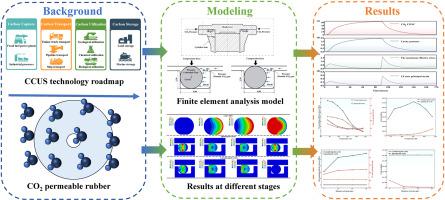Fatigue lifetime prediction of rubber O-rings in CCUS systems: A coupled diffusion-deformation-fatigue model
IF 4.2
3区 工程技术
Q2 ENGINEERING, CHEMICAL
Journal of Loss Prevention in The Process Industries
Pub Date : 2025-08-28
DOI:10.1016/j.jlp.2025.105765
引用次数: 0
Abstract
Carbon capture, utilization, and storage (CCUS) technology serves as a critical approach for industrial emissions reduction. However, during high-pressure CO2 pipeline transportation, the sealing performance of rubber O-rings at the pipeline end quick-opening blind flange is crucial to system integrity. Seal failure may not only lead to substantial CO2 leakage, significantly compromising the CCUS system's emission reduction efficiency, but also pose serious safety hazards due to sudden high-pressure gas release. Current research on the diffusion behavior of CO2 in rubber materials and the impact of its induced deformation on the fatigue life of sealing components remains notably insufficient. To address this issue, this study develops a finite element analysis (FEA) model coupling diffusion-deformation-fatigue life based on gas diffusion and hyperelasticity theories to assess the fatigue life of rubber O-ring. The results show that a moderate compression proportion (approximately 15 %) is beneficial for prolonging the O-ring fatigue life while minimizing leakage risks. Increasing cavity diameter reduces the fatigue life of the O-ring. As CO2 pressure increases from 1 MPa to 5 MPa, the fatigue life of O-rings with cavities decreases from infinity to 7.36 cycles. Moreover, the acceleration of the depressurization rate adversely affects the fatigue life of O-rings containing cavities. The results provide essential guidelines for optimizing the design of CCUS pipeline sealing systems, ensuring long-term operational reliability of high-pressure CO2 transportation infrastructure while mitigating potential safety hazards induced by seal failure.

CCUS系统橡胶o形圈疲劳寿命预测:扩散-变形-疲劳耦合模型
碳捕获、利用与封存(CCUS)技术是工业减排的重要途径。然而,在高压CO2管道输送过程中,管道端快开盲法兰橡胶o形圈的密封性能对系统的完整性至关重要。密封失效不仅会导致大量CO2泄漏,严重影响CCUS系统的减排效率,还会因高压气体突然释放而造成严重的安全隐患。目前对CO2在橡胶材料中的扩散行为及其诱导变形对密封构件疲劳寿命影响的研究还明显不足。针对这一问题,本研究基于气体扩散和超弹性理论,建立了扩散-变形-疲劳寿命耦合有限元分析模型,对橡胶o形圈的疲劳寿命进行了评估。结果表明,适当的压缩比(约15%)有利于延长o形圈的疲劳寿命,同时降低泄漏风险。增大腔直径会降低o形圈的疲劳寿命。当CO2压力从1 MPa增加到5 MPa时,带腔o形圈的疲劳寿命从无限大降低到7.36次。减压速率的加快对含腔o形环的疲劳寿命有不利影响。研究结果为CCUS管道密封系统的优化设计提供了重要指导,确保高压二氧化碳运输基础设施的长期运行可靠性,同时减轻密封失效带来的潜在安全隐患。
本文章由计算机程序翻译,如有差异,请以英文原文为准。
求助全文
约1分钟内获得全文
求助全文
来源期刊
CiteScore
7.20
自引率
14.30%
发文量
226
审稿时长
52 days
期刊介绍:
The broad scope of the journal is process safety. Process safety is defined as the prevention and mitigation of process-related injuries and damage arising from process incidents involving fire, explosion and toxic release. Such undesired events occur in the process industries during the use, storage, manufacture, handling, and transportation of highly hazardous chemicals.

 求助内容:
求助内容: 应助结果提醒方式:
应助结果提醒方式:


